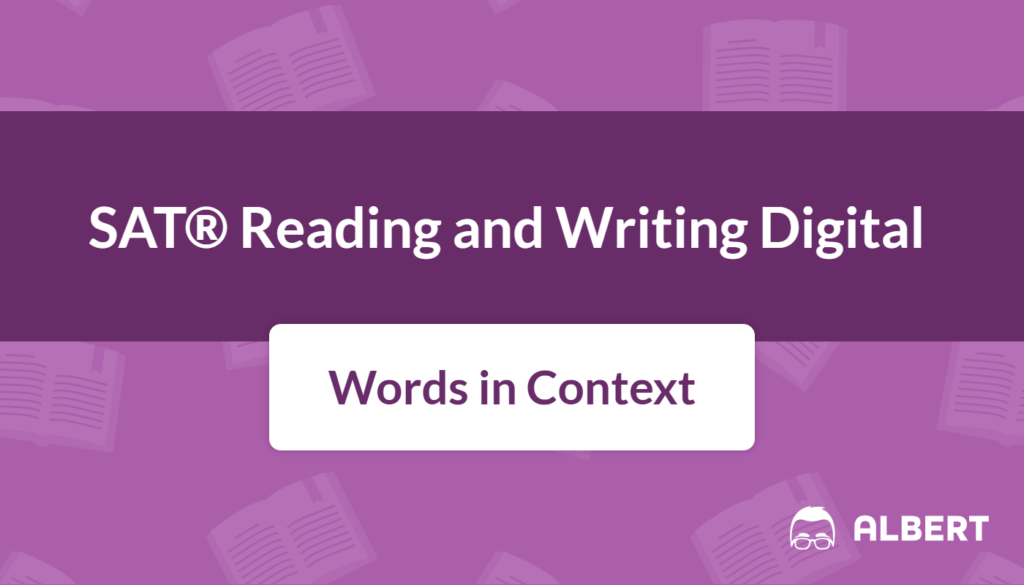What We Review
Understanding Context Clues for the SAT® Reading and Writing Test
Context clues are often overlooked, but they play an essential role in reading comprehension and vocabulary skills. On the SAT® Reading and Writing Test, words in context can be tricky. Yet, with the right strategies, these questions can become much easier. Therefore, learning how to spot and interpret context clues can quickly boost test performance. This article explores various types of context clues, highlights the difference between connotation vs. denotation, and offers useful practice exercises.
What Are Context Clues?
Context clues are hints or pieces of information found near a word or phrase. These clues help the reader figure out the meaning even if the word is unfamiliar. When a passage includes an unfamiliar term, the surrounding sentences or phrases can guide you to the correct definition. As a result, context clues help readers understand complex material more quickly.
When facing a tough vocabulary question on the SAT®, rely on the clues in the passage. Rather than skipping the word, look for details that point to its meaning. Clues might include examples, definitions, or even opposites of the unknown word.
Types of Context Clues
There are several types of context clues. Recognizing them can make reading passages less intimidating. Below are five main types: definition, synonym, antonym, examples, and inference clues.
1. Definition Clues
A definition clue is one of the easiest to spot. Writers sometimes provide a direct explanation of a word. Often, this can appear in parentheses or immediately after the word.
Example Sentence:
“The arboretum, a place where various trees are cultivated, is a great place to visit.”
Step-by-Step Solution:
- Identify the unfamiliar word: “arboretum.”
- Notice the phrase that follows: “a place where various trees are cultivated.”
- Recognize that this phrase provides a direct definition.
- Conclude that “arboretum” is a location dedicated to growing different types of trees.

2. Synonym Clues
Synonyms are words with similar meanings. In many sentences, a writer includes a synonym near the unfamiliar term to help clarify it. Therefore, watch for a word that resembles the meaning of the unknown word.
Example Sentence:
“The immigrant felt a deep nostalgia for his homeland, filled with yearning for his past.”
Step-by-Step Solution:
- Spot the word “nostalgia.”
- Observe the phrase “filled with yearning for his past.”
- See that “yearning” closely matches “nostalgia.”
- Realize that “nostalgia” refers to a strong longing for something from the past.
3. Antonym Clues
Antonym clues involve a contrast. Since antonyms have opposite meanings, clues in the sentence might signal a deliberate difference. Words like “unlike,” “however,” or “in contrast” often introduce this type of clue.
Example Sentence:
“Unlike her gregarious brother, who loved social gatherings, she was quite reserved.”
Step-by-Step Solution:
- Notice the word “gregarious.”
- Identify the contrast word: “Unlike.”
- See that “gregarious” is the opposite of “reserved.”
- Infer that “gregarious” means outgoing, sociable, or friendly.
4. Examples Clues
Example clues describe the unknown word by listing specific instances. Writers often introduce these clues with phrases such as “such as,” “for example,” or “including.”
Example Sentence:
“The naturalist enjoyed observing wildlife, such as otters, red-tailed hawks, and elk.”
Step-by-Step Solution:
- Look at the word “wildlife.”
- Notice the examples that follow: “otters, red-tailed hawks, and elk.”
- Realize they are animals living in nature.
- Understand that “wildlife” refers to animals that exist in their natural habitat.
5. Inference Clues
Inference clues are slightly less direct. The meaning of the word can be understood by looking at the overall context of the sentence or paragraph. Therefore, pay close attention to the main idea.
Example Sentence:
“After the tumultuous events of the day, he felt a sense of calm wash over him.”
Step-by-Step Solution:
- Identify the key word: “tumultuous.”
- Observe the contrast: “tumultuous events” versus “a sense of calm.”
- Infer that “tumultuous” suggests chaos or disorder.
- Conclude that the day was filled with intense or disruptive happenings.
Connotation vs. Denotation
Understanding “connotation vs. denotation” helps you choose the best word in a given context. Denotation is the straightforward meaning of a word, as found in dictionaries. Connotation, however, is the emotional or cultural feeling a word carries. Paying attention to both helps when selecting precise words on the SAT®.
Example of Denotation vs. Connotation:
- Word: “Home”
- Denotation: The place where one lives.
- Connotation: Safety, comfort, and warmth.
Step-by-Step Solution:
- Recognize “home” refers to a physical location.
- Note the emotional aspect of safety and comfort.
- Understand how the connotation can shift the tone of a sentence.
- Conclude that word choice can affect the emotional response of readers.
When a test question asks for the most precise word or phrase, always consider the connotation and the denotation. If the passage aims for a nostalgic feel, a word with a positive connotation might be best. But if the passage intends to sound clinical, the purely literal term might be more suitable.
Strategies for Using Context Clues Effectively
- Read Surrounding Sentences: Writers often place context clues in the same sentence or nearby paragraphs. Therefore, do not rush; read carefully for references that point to the meaning of an unknown term.
- Look for Signal Words: Terms like “unlike,” “for instance,” or “in contrast” can guide you toward definitions, synonyms, or antonyms. If a sentence includes “or” before a new phrase, that phrase might be a restatement of the unknown word.
- Practice Regularly: Reading various texts, such as articles and essays, develops familiarity with common vocabulary. This practice also enhances reasoning skills when encountering complex passages on the SAT®.
Practice Exercise
Read the paragraph below. Each underlined word or phrase can be understood using context clues. Fill in the blank with the best meaning. Then, check the step-by-step solution.
Paragraph:
“It was a(n) unpredictable day, marked by sudden changes in weather. First, the sky was overcast (), but within minutes it became bright and clear (). Despite the erratic (__________________) weather, people continued their outdoor activities.”
- “unpredictable” = (a) uncertain or changeable, (b) standard or typical
- “overcast” = (a) covered with clouds, (b) delightfully sunny
- “bright and clear” = (a) rainy and gloomy, (b) full of sunlight and no clouds
- “erratic” = (a) unpredictable or inconsistent, (b) calm and steady
Step-by-Step Solution
1. “unpredictable”
- The paragraph states there are “sudden changes in weather.”
- Therefore, “unpredictable” means (a) uncertain or changeable.
2. “overcast”
- Contrasted with “bright and clear,” it likely involves clouds.
- Hence, “overcast” is (a) covered with clouds.
3. “bright and clear”
- This is the opposite of overcast.
- The best choice is (b) full of sunlight and no clouds.
4. “erratic”
- The paragraph mentions quick shifts in weather.
- So, “erratic” means (a) unpredictable or inconsistent.
Quick Reference Vocabulary Chart
Copy and paste the table below into a Google Doc for easy reference:
| Word | Definition |
| Context Clue | Hints or information surrounding a word to derive meaning. |
| Denotation | The literal meaning of a word. |
| Connotation | The emotional or implied meaning of a word. |
| Inference | A conclusion drawn from the given context. |
| Synonym | A word with a similar meaning. |
| Antonym | A word with the opposite meaning. |
| Example | A specific instance that illustrates a concept. |
Conclusion
Context clues are powerful tools for understanding unfamiliar words in a passage. By recognizing how surrounding phrases and sentences work together, it becomes easier to decode new vocabulary. This skill is especially important for tackling words in context on the SAT® Reading and Writing Test. Furthermore, remembering the distinction between connotation vs. denotation ensures the use of precise language that fits each situation.
With regular practice and an awareness of these strategies, students can greatly improve their comprehension, vocabulary, analysis, and synthesis skills. Whether facing simple definition clues or more subtle inference clues, careful reading and consistent exposure to various texts will strengthen confidence. Ultimately, context clues open new doors to understanding complex materials, leading to success on the SAT® and beyond.
Sharpen Your Skills for SAT® Reading and Writing
Are you preparing for the SAT® Reading and Writing test? We’ve got you covered! Try our review articles designed to help you confidently tackle real-world SAT® Reading and Writing problems. You’ll find everything you need to succeed, from quick tips to detailed strategies. Start exploring now!
- Text Structure and Purpose: SAT® Reading and Writing Review
- Compare and Contrast: SAT® Reading and Writing Review
- Central Idea: SAT® Reading and Writing Review
Need help preparing for your SAT® Reading and Writing exam?
Albert has hundreds of SAT® Reading and Writing practice questions and full-length practice tests to try out.








